Cartoons and propaganda: Osbert Lancaster at the PWE
Document of the month: FO 898/507
Guy Woodward investigates the involvement of Daily Express cartoonist Osbert Lancaster in wartime propaganda
This booklet entitled Moffes-Spiegel measures 10.5 x 13 cm and appears in file 898/507 ‘Dutch Leaflets and Booklets’. Produced for the Netherlands, it contains a series of cartoons ridiculing the Nazi high command and other German officials, all of which were originally drawn for the Daily Express by Osbert Lancaster (1908-86).
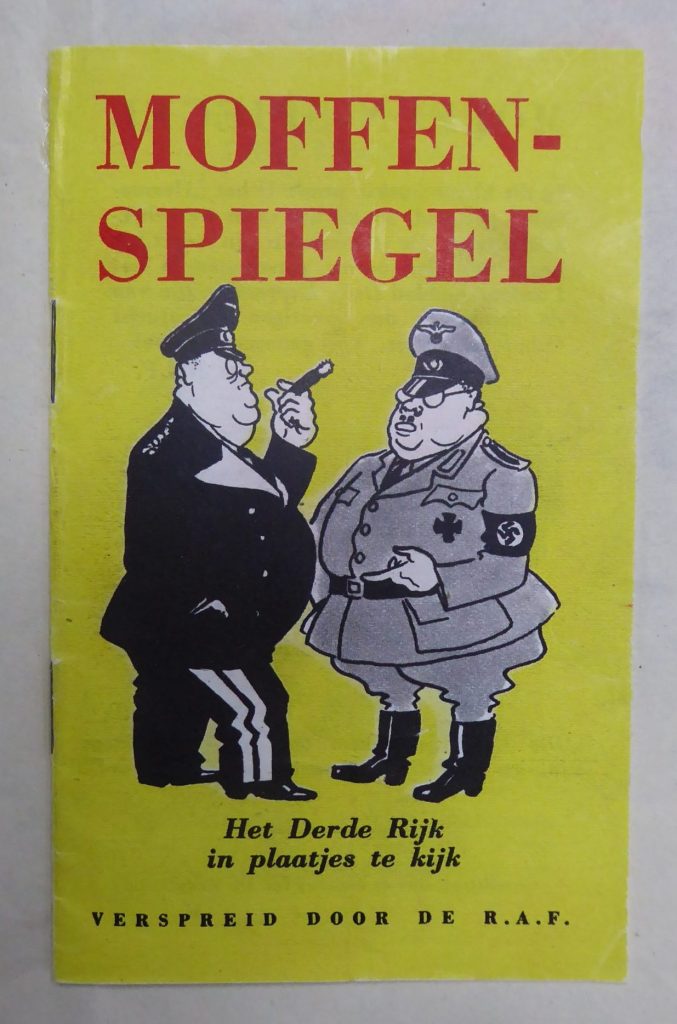
‘Mof’ is a derogatory slang term for ‘German’, and ‘Spiegel’ is ‘mirror’: the title has been translated by the invaluable online resource psywar.org as ‘The Image of the Hun.’[1] A message on the opening page signed by ‘The RAF’ crediting Lancaster as artist promises that the cartoons present the Herrenvolk ‘as they really are’.[2] Psywar notes that 66,100 copies of the booklet were dropped over the Netherlands in seven separate missions in mid-September and early October 1942, and then again in early March 1943.
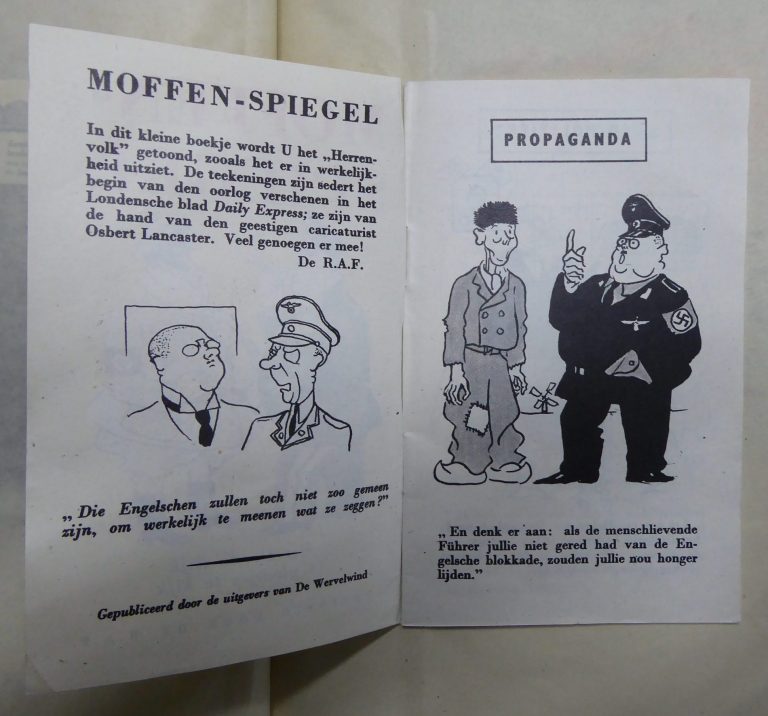
Several cartoons in the booklet address the subject of propaganda – the first in the booklet (above) shows a German military figure asking a civilian: ‘Surely the English couldn’t be so deceitful as to mean what they say?’ Facing this, a cartoon under the heading ‘Propaganda’ depicts a portly SS officer sententiously admonishing a malnourished Dutch civilian, telling him ‘Remember if the kind Führer hadn’t rescued you from the brutal British blockade you’d be starving by now.’[3]
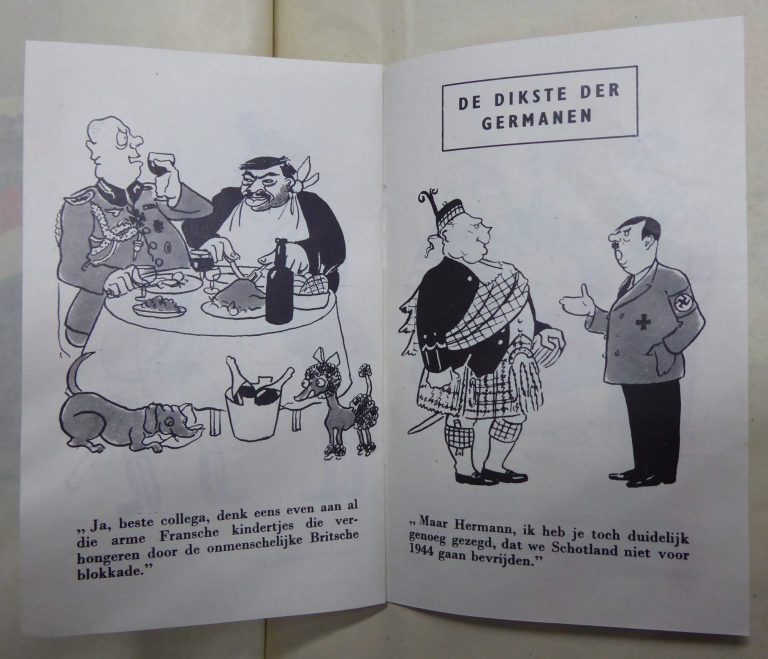
In other cartoons Lancaster addresses the gluttony of senior Nazis more directly – this was a popular theme in British propaganda to occupied Europe, as I explored in a post last May. The cartoon on the left page above shows two men tucking into a feast, with the caption ‘Just think, dear colleague, of all those poor French children starving because of the brutal British blockade.’[4] The cartoon facing this attacks the Supreme Commander of the Luftwaffe Hermann Göring, whose obese form and famed vanity made him a popular target of British wartime satire. Under the heading ‘The Fattest of Teutons’, we see Göring in full Highland dress, as Hitler admonishes him: ‘But, Hermann, I told you distinctly that we are not liberating Scotland until 1941.’[5] Other cartoons seek to emphasise the brutality and deceitful nature of German military campaigns – under the ironic heading ‘Blitzkrieg’ we see a Luftwaffe bomber firing on a pram at close range as one airman says to another ‘Well, we can always say we thought it was a tank’ (below, right).[6]
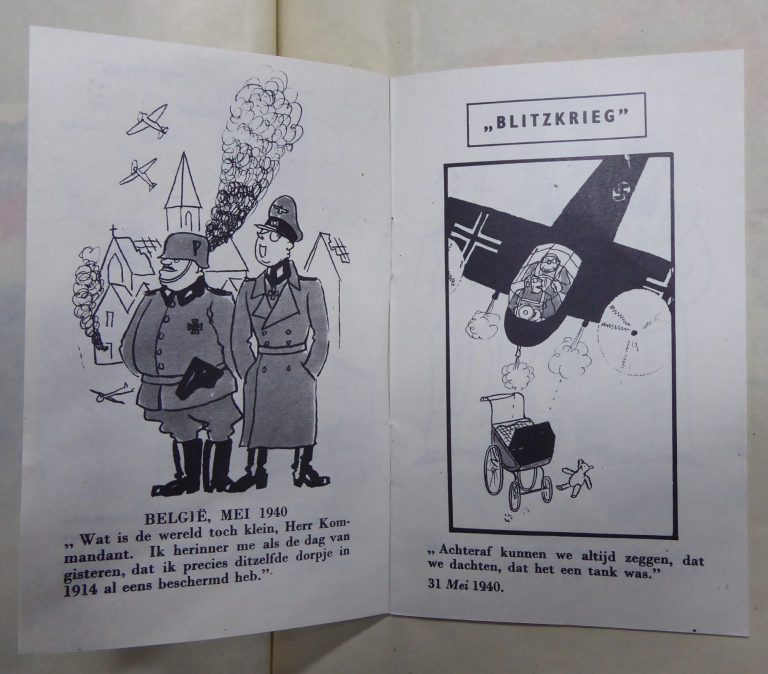
Lancaster’s attacks were informed by direct observation: like many who worked in British wartime propaganda departments, Lancaster had first-hand experience of the rise to power of the Nazis in Germany. In 1933 he took a skiing holiday with his future wife Karen in Bavaria; he recalled in his memoir arriving at the colourful Alpine town of Mittenwald, and feeling uneasy when he saw an immense banner reading ‘Hitler wird Kanzler sein’. That night the couple observed a torchlit procession from their hotel balcony, and heard the ‘booming of the village band punctuated by throaty “Sieg Heils”.’[7] Visiting Munich a few years later, the couple were shocked when they discovered that German friends of Karen had become confirmed supporters of the Nazi party.[8]
Lancaster began contributing a daily pocket cartoon to the Daily Express on 1 January 1939; remarkably these appeared until his retirement in 1981. He recalled in his memoir that he was taken on by the newspaper after he approached the features editor John Rayner and volunteered his services as a cartoonist.[9] The connection with Rayner is significant: an expert on typeface and design who had revolutionised the appearance of the Express in the 1930s, Rayner worked for the PWE during the war in a number of areas, including printed propaganda, radio broadcasting, and the LINK! production of sibs (rumours intended to deceive or demoralise the enemy).[10]
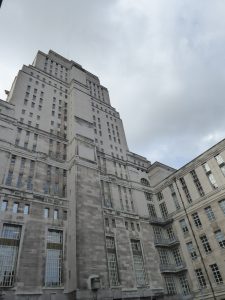
The exact nature of Lancaster’s own wartime activities in this field are unclear: frustratingly his memoir With an Eye to the Future (1967) ends with the declaration of war. According to his biographer James Knox, a few months after this in late 1939 Lancaster was employed by the Ministry of Information (MOI), and worked at Senate House, Bloomsbury (left), in a ‘department responsible for the release of overseas news to the British press and, as part of the propaganda war, to enemy, neutral and allied nations.’[11] In 1941 Lancaster was transferred to the Foreign Office ‘News Department’, but remained at Senate House and continued to brief journalists; he also worked shifts monitoring German radio broadcasts.[12]
A garrulous and sociable figure who loved gossip, Lancaster was certainly busy during the war: in addition to his work at Senate House, he continued producing daily cartoons for the Express, worked as art critic for the Observer and book reviewer for the Spectator, and frequently appeared as a panel member on radio discussion programmes.[13]
Cartoons, it is clear, are a particularly useful form of transnational propaganda, since ridicule through caricature can be easily understood across borders and cultures: like his fellow cartoonists Carl Giles and David Low, Lancaster’s works were frequently reprinted in PWE leaflets and periodicals during the war: However, fragments in biographies of Lancaster and in the memoirs of those who knew him suggest that earlier in the war he also worked directly for the organisation as an artist, at its Country headquarters at Woburn Abbey (below). His friend Peter Quennell, who had a tedious job as press censor at the MOI in the early years of the war, recalled his envy of Lancaster’s attachment to Woburn and involvement in ‘secret campaigns’.[14] Another biographer Richard Boston notes that Lancaster and Karen for a time rented a cottage with fellow Express cartoonist and PWE artist Walter Goetz and his wife Toni in Aldworth, Berkshire (Boston suggests this was ideally located for Woburn, which does not really make sense – even today it is around 1hr 45 m drive away).[15]
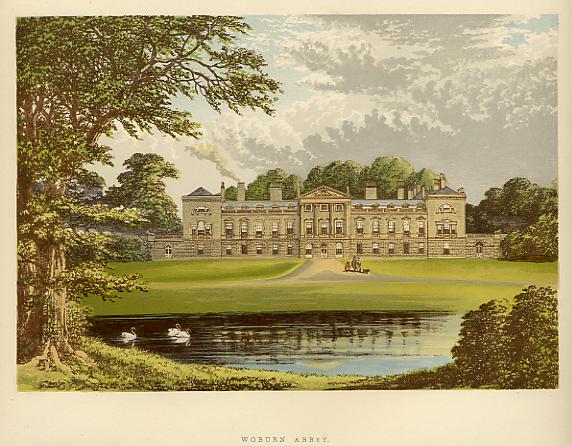
Lancaster’s exact role at Woburn remains unclear, but his social and professional connections with PWE figures were notably extensive. In December 1944 he was sent by the FO from London to Greece, where he served as press attaché to the British Embassy and GHQ in Athens, managing a propaganda campaign against the communist insurgency under Ambassador Rex Leeper – executive head of the PWE from 1941-43. And in addition to his friendship with Rayner (to whom his 1941 collection New Pocket Cartoons was dedicated), Lancaster also knew Freya Stark, whose role in wartime propaganda I examined in a previous blog post: he apparently decorated the bathroom at her house in Asolo, northern Italy, shortly after the war.[16]
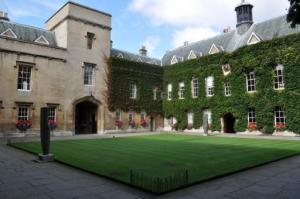
The connections can be traced over two decades: as a student at Oxford in the late 1920s, Lancaster had encountered several figures who would later play prominent roles in the British wartime propaganda campaign. A fellow student at Lincoln College (right) was Sefton Delmer, another Express man who became PWE’s black propaganda supremo two decades later. Delmer attempted without success to instruct him in rowing, but Lancaster was more interested in aesthetic and cultural pursuits: he describes taking part in a production of King Lear in which several figures later associated with propaganda and secret work were cast.[17] Lear was played by Harman Grisewood, Assistant Controller of the BBC’s European Service during the Second World War and therefore heavily involved in PWE planning. John Betjeman, later ‘PWE’s chosen instrument in Dublin’ during the war (I wrote about this in November 2018), had been cast as the Fool, but was ejected from the production when the Betjeman-edited Cherwell magazine printed satirical photographs of rehearsals of the play.[18] Meanwhile the Duke of Cornwall was played by Peter Fleming, whose wartime roles in British intelligence and irregular warfare were many and various, and included ‘head of deception’ in India from 1942-45.[19]
At first glance such anecdotes may appear trivial, but Lancaster’s wartime career surely indicates the extent to which recruitment to the PWE and other associated British propaganda organisations was determined by a relatively narrow and interconnected series of social and professional networks.
Images by kind permission of The National Archives
Notes
[1] Translation provided by psywar.org: https://www.psywar.org/product_1942H019.php
[2] Ibid.
[3] Ibid.
[4] Ibid.
[5] Ibid.
[6] Ibid.
[7] Osbert Lancaster, With an Eye to the Future (London: John Murray, 1967), p. 117.
[8] Ibid., p. 140.
[9] Ibid., p. 149.
[10] Artemis Cooper, Patrick Leigh Fermor: An Adventure (London: John Murray, 2012), p. 199; Simon Fenwick, Joan: Beauty, Rebel, Muse: The Remarkable Life of Joan Leigh Fermor, (London: Pan Macmillan, 2017), chapter 6 (unpaginated); Eunan O’Halpin, Spying on Ireland: British Intelligence and Irish Neutrality During the Second World War, (Oxford University Press, 2008), p. 211.
[11] James Knox, Cartoons & Coronets: The Genius of Osbert Lancaster (London: Francis Lincoln, 2008), p. 48.
[12] Ibid., p. 49.
[13] Richard Boston, Osbert: A portrait of Osbert Lancaster (London: Collins, 1989), p. 126.
[14] Peter Quennell, The Wanton Chase: An Autobiography from 1939 (London: Collins, 1980), p. 14.
[15] Boston, p. 122.
[16] Maurice Cardiff, Friends Abroad (London, New York: The Radcliffe Press, 1997), p. 87.
[17] Lancaster, With an Eye to the Future, p. 66.
[18] O’Halpin, p. 210.
[19] Rupert Hart-Davis, ‘Fleming, (Robert) Peter’ (2004), Oxford Dictionary of National Biography: https://doi-org.ezphost.dur.ac.uk/10.1093/ref:odnb/31114.
